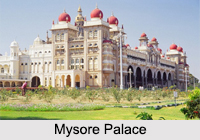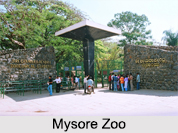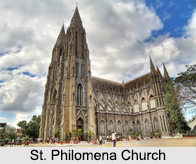 Tourism in Mysore or Mysuru is decorated with the well maintained palaces and art galleries, temples and mosques that narrate the ultra royal lifestyle of Mysore.
Tourism in Mysore or Mysuru is decorated with the well maintained palaces and art galleries, temples and mosques that narrate the ultra royal lifestyle of Mysore.
Mysore or Mysuru includes some major sites of tourism which mainly includes the royal Mysore Palace, St. Philomena Church, Sand Sculpture Museum, Regional Museum of Natural History, Folk Lore Museum, Railway Museum, Oriental Research Institute, Shri Jayachamarajendra Art Gallery, Jaganmohan Palace and Mysore Zoo.
Mysore Palace
 The glorious Mysore Palace was built thousand years ago in 897 AD. Built in a Saracenic style this palace includes a massive hall made up of gray granite, covered with a tower and a dome. The palace also includes a temple which is built at the centre of the court yard. While the original palace was burnt in a severe fire the present palace was rebuilt by Krishnaraja Wodeyar IV which continues to exist even today.
The glorious Mysore Palace was built thousand years ago in 897 AD. Built in a Saracenic style this palace includes a massive hall made up of gray granite, covered with a tower and a dome. The palace also includes a temple which is built at the centre of the court yard. While the original palace was burnt in a severe fire the present palace was rebuilt by Krishnaraja Wodeyar IV which continues to exist even today.
Mysore Zoo
Mysore Zoo has an exclusive collection of some rare animals which were collected by the royal family of Mysuru.
St. Philomena`s Cathedral
St. Philomena`s Cathedral is a Catholic church of Mysuru. St. Philomena`s Cathedral was constructed in 1936 using a Neo Gothic style and its architecture was inspired by the Cologne Cathedral in Germany.
Folklore Museum
Folklore Museum is a unique museum in Mysore that exhibits the architecture of South India and the north Indian folk art and crafts. Here also depicts the history of Karnataka in art formation. Art in India is truly portrayed here.
Railway Museum
Railway Museum in Mysore is an outdoor exhibit of vintage locomotives that emerged during British era. The Railway Museum was established in 1979 by Indian Railways, which shows the history of locomotives. There is a gallery of photographs and paintings depicting the growth of Railways in India. The railway signals and lights are also displayed. Railway Museum also offers the toy train rides. 
Oriental Research Institute
Oriental Research Institute is a research institute which collects, exhibits, edits, and publishes rare Indian manuscripts and Indian Scripts like Devanagari language, Brahmic language (Kannada language), Nandinagari language (Sanskrit language), Grantha, Malayalam language and Tigalari language.
Mysore is serving as the biggest tourist hotspot in the itinerary of Karnataka tourism. It attracts the tourists not only towards the glorious past of Mysore but also towards the scenic beauty of Chamundi Hills which surrounds the city from all sides.
Visiting Information
Mysore is connected by National Highway NH-212 to Gundlupet, where the road bifurcation reaches to Kerala and Tamil Nadu. Mysore Railway Station connects with Bengaluru, Mangalore and Chamarajanagar. Mysore Airport is a major airport to connect with all the cities of India.



















